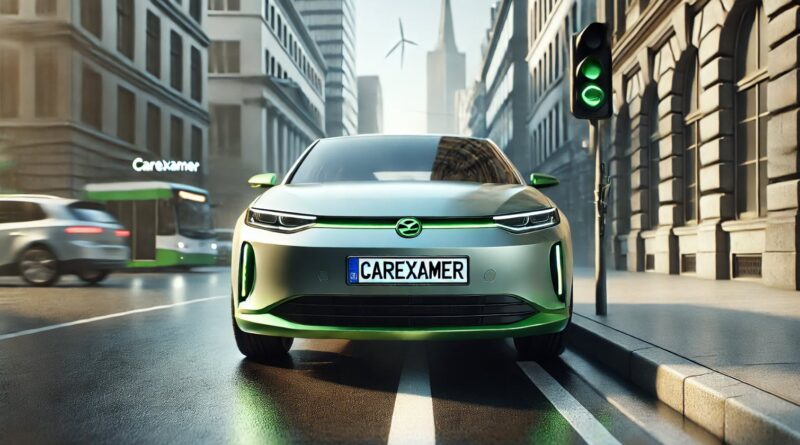Guide Green Number Plates
Here’s everything you need to know about green number plates and what they signify. If you’ve been seeing cars with green number plates on the road, you’re not alone. Introduced in the UK in December 2020, these green plates are part of a wider initiative to encourage the adoption of electric vehicles (EVs) and raise awareness about eco-friendly transportation. But what exactly do these number plates mean, and why do they matter?
1. What Are These Green Plates?
Green plates are designed for fully electric vehicles (EVs) in the UK. Unlike the standard number plates, these have a green flash or strip on the left side of the plate. This distinguishing feature helps identify zero-emission vehicles on the road. The idea behind green plates is to raise the profile of electric vehicles and make them more easily recognisable.
While the plates are voluntary, they’ve gained popularity as more drivers switch to electric cars and want to take advantage of certain perks.
2. Who Can Get Green Plates?
Only vehicles that are fully electric qualify for green plates. This means cars, vans, buses, and even motorcycles that are zero-emission can display these plates. It’s important to note that hybrid vehicles, which combine electric and traditional fuel engines, do not qualify for green plates since they still produce emissions.
If you own or are planning to buy a fully electric car, you can request a green number plate when registering the vehicle or, if your vehicle is already registered, you can have your current plate swapped out for a green one.
3. Benefits of Green Plates
One of the key reasons drivers opt for green number plates is the range of potential benefits that come with them. Although many of these benefits are still in the planning stages, local authorities and government bodies are working on several incentives for drivers of zero-emission vehicles. Some of these include:
1. Cheaper or Free Parking
Local councils may offer free or discounted parking for electric vehicles with green number plates. Some areas already have pilot schemes in place where EV drivers can park for free or at reduced rates.
2. Access to Low-Emission Zones
In the future, it’s likely that cars with green plates will have privileged access to low-emission zones or be exempt from congestion charges. This could make driving in city centres more affordable and hassle-free for EV drivers.
3. Raising Awareness
Another benefit of green number plates is the visibility it gives to electric cars. By having more cars with green plates on the road, the government hopes to encourage more people to consider switching to an EV, helping to build momentum towards the UK’s goal of banning new petrol and diesel car sales by 2030.
4. Possible Tax Benefits
While there are no specific tax benefits linked to green number plates yet, some speculate that in the future, vehicles with these plates could qualify for certain tax incentives, particularly as the UK works towards its green energy goals.
4. How to Get Green Plates
If you own a fully electric vehicle and want to get a green number plate, it’s a straightforward process:
- New vehicles: If you’re buying a new EV, you can request a green number plate when you register the car.
- Existing vehicles: If your electric vehicle already has a standard number plate, you can visit your local vehicle plate provider and request a switch to a green one. You’ll need to provide proof of ownership and vehicle registration to get the plates swapped.
There is no additional fee for choosing a green plate, but you may need to pay the standard cost for getting a new set of plates made.
5. The Future of Green Plates
As the UK moves towards its goal of net zero emissions by 2050, green number plates are expected to play a bigger role in the transition to electric vehicles. Here are a few ways they might shape the future of driving:
- More incentives: As green number plates become more common, local councils and the government are likely to offer additional benefits to EV owners, including expanded free parking, tax breaks, or reduced tolls.
- Wider adoption of EVs: By making electric cars more visible on the roads, green number plates can help normalise EVs. It should free choice to any driver to choose what fuel choice they may choose.
- Clear distinction for low-emission zones: As more low-emission zones are introduced across the UK, green number plates could make it easier for authorities to identify eligible vehicles, helping to enforce clean air initiatives.
6. Are There Any Disadvantages?
While green plates are largely seen as a positive move towards encouraging sustainable transport, there are a few potential downsides:
- Privacy concerns: Some drivers may worry that having a green plate makes them stand out too much, particularly in areas where electric vehicles are still relatively rare.
- Limited benefits: Although the plates are intended to offer various perks, many of these are still in the planning stages and not yet widely available.
Despite these concerns, the advantages of green plates, especially as the infrastructure for EVs improves, are likely to outweigh the disadvantages.
Conclusion
Green plates are part of the UK’s broader push towards sustainable transport and the adoption of electric vehicles. While not mandatory, they offer several potential benefits, including free parking and easier access to low-emission zones. For those driving fully electric vehicles, green plates are an opportunity to not only take advantage of these perks but also to contribute to raising awareness about eco-friendly transportation options.
As the shift towards electric vehicles gains momentum, green number plates will likely become a more common sight on UK roads, making them a key part of the country’s journey towards reducing carbon emissions.
Buying a used VW. Buying used vauxhall, BMW, Jaguar, Ford, Volvo, Range rover, Bentley, Aston Martin, Porsche, Ferrari, Lamborghini, Maserati, Hyundai, Tesla, Honda, Pagani

